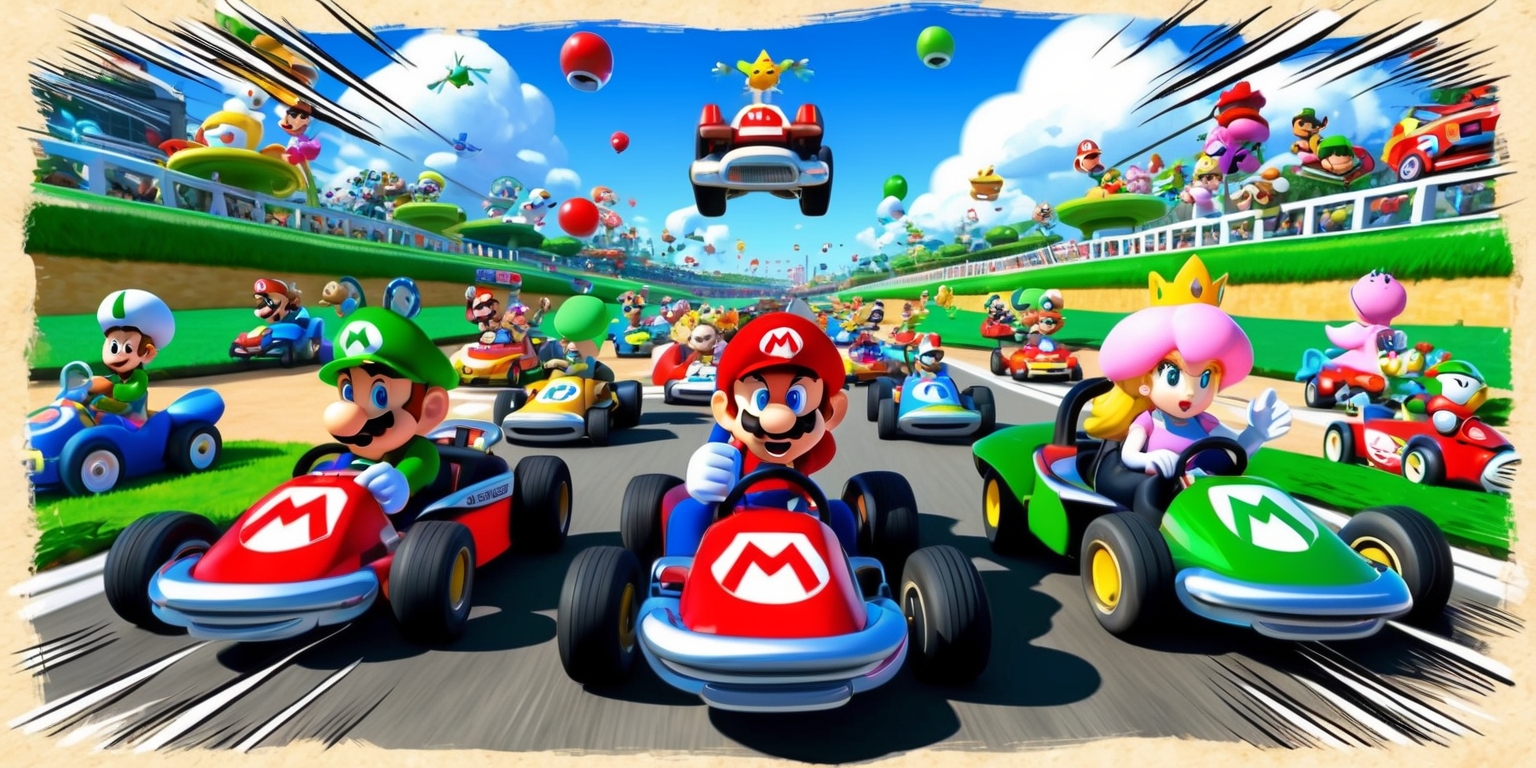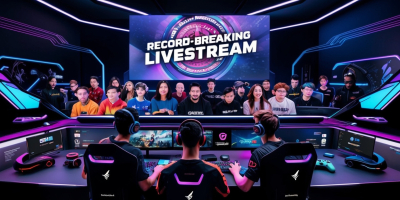Mastering the Perfect Start: Unleashing the Boost in Mario Kart World
- Jun 06, 2025

Mario Kart World reinvents the familiar kart racing experience through its expansive open world and refined gameplay elements that challenge both newcomers and veterans alike. The game maintains much of its classic charm while introducing bold features, such as its umbrella connection of courses and a meticulously designed boost mechanic at the race’s onset. In this dynamic environment, every fraction of a second counts, with precise timing playing a crucial role in determining your initial pace. As racers prepare to surge forward, understanding how to harness that initial burst of speed holds the promise of competitive advantage. The following exploration delves into various aspects of the boost technique, offering insights into timing strategies, visual cues, and the overall impact of a well-executed start.
Immersive Open World and Kart Dynamics
Mario Kart World not only upgrades the traditional kart racing formula but also builds a fully explorable open environment where each course interconnects with its neighbors. This setting shifts the emphasis from isolated tracks to a seamlessly integrated racing universe, infusing each moment with an element of discovery. Among the many features that captivate players, the boost mechanic at the start is a prime example. This mechanism requires an immaculate blend of focus and timing, ensuring that your kart surges ahead at the precise moment the race begins. Embracing these dynamic elements means that players must adapt quickly. The autonomous environment interacts with your performance, creating a thrilling mix of strategy and real-time adjustment as you optimally position yourself among the queue of racers.
Refined Mechanics and Signature Abilities
Central to Mario Kart World's charm is the integration of familiar mechanics with innovative ideas that amplify user engagement. The racing experience has evolved, yet it retains the signature boost ability reminiscent of past titles. This early boost, occasionally referred to as the “rocket start” in earlier editions, remains a critical tool for those aiming to stay ahead of the pack. Achieving this boost involves more than just rapid button mashing—it demands a delicate balance between timing and anticipation. Players are encouraged to engage with the in-game feedback mechanisms that guide their readiness. By analyzing these nuances, you learn to harness the precise moment of acceleration and transform your performance, all while appreciating the richly detailed environment around you.
Timing Techniques and Preparing for the Surge
At the heart of an effective race commencement lies the mastery of timing. The trick is to press the accelerator at a moment defined by both visual and auditory signals, ensuring that your kart receives the maximum potential thrust right at the start. This approach centers on the number displayed during the countdown. When the digit '2' is fully visible, players are prompted to engage the accelerator. Slight delays or premature actions have direct consequences, either resulting in a modest boost or, worse, a noticeable delay in progress. Such precise coordination between sight and action not only underscores the challenge posed by the game but also adds layers of exhilaration as you strive to fine-tune your response, making every race a personal quest to improve your standing.
Deciphering Visual and Auditory Cues

The game provides an intricate system of cues that guide players towards an optimal starting boost. Visual indicators, like the clear appearance and eventual fade of the numeral in the countdown, serve as critical markers. In addition, the behavior of in-game characters, such as the position of the referee figure, offers supplementary hints to those who pay close attention during the countdown phase. These enhancements not only provide depth to the gameplay but also encourage players to exercise both their reflexes and cognitive abilities. By training your focus on these subtle signals, you build a symbiotic relationship with the game’s pacing—an alliance that rewards precision and attentive observation, and sets the groundwork for a faster start amidst the bustling competition on the track.
Boost Execution and Strategic Advantage
The pursuit of the perfect start in Mario Kart World is a delicate dance of technique and nerve. The right moment to press the accelerator is at the complete appearance of the '2' in the countdown. Achieving this precise moment triggers the full potential of your kart's boost, setting you on course ahead of many rivals. A successful execution has a cascading positive effect, not only providing immediate speed but also building the momentum you will carry throughout the race. Utilization of this technique requires patience and an understanding of the game's mechanics, stressing thoughtful action over impulsivity. In the heat of the race, when every second is magnified by the competitive energy on the track, this early surge can redefine your strategy and potentially pave the way to victory.
Balancing Patience and Aggression
While the temptation to accelerate too quickly can be intense, caution is rewarded in Mario Kart World. The margin for error is narrow, as applying the throttle prematurely can lead to a temporary stall, losing precious seconds and allowing competitors to surge ahead. The game’s design reinforces the importance of restraint; it is far better to hold the accelerator and act just a fraction late than to misjudge the timing and disrupt your momentum entirely. This balanced approach, where the measured application of power counts, emphasizes a broader strategic framework. By respecting the mechanics and avoiding rash decisions, you learn to harness your capabilities in a controlled burst that can propel you forward, even in the fast-moving chaos of the race’s earliest moments.
In-game Indicators and Motor Control
In mastering the boost, players must master an interplay between the game’s inherent indicators and their own motor control. The countdown isn’t merely a timer—it’s a meticulously designed signal that communicates the optimal moment to start accelerating. Paying attention to the subtleties of the displayed numeral and the referee figure's arm creates an informed basis upon which you can build your strategy. This symbiosis between sensory input and physical reaction echoes the notion that video games are an art form where precision and anticipation merge seamlessly. The boost mechanic becomes a microcosm of the game’s overall rhythm, requiring that you be both an active observer and a timely executor, harmonizing every element to extract maximum performance from your kart.
Practical Application in High-Pressure Scenarios
When tenseness mounts at the starting line, practical knowledge of the exact timing required for an effective boost can be a deciding factor between leading the race or trailing behind. High-pressure moments call for calm discipline and a familiarity with every nuance of the starting signals. In these instances, systematic practice allows you to internalize the precise moment when the countdown transitions from anticipation to action. This level of skill emerges from repeated attempts and a willingness to adjust your timing based on live feedback from the game. By remaining composed and reacting through practiced muscle memory, you are better prepared to secure that critical acceleration, making every race a testament to your growing expertise under pressure.
Developing Consistency Through Repetition
Consistent performance in executing an early boost is It didn’t develop overnight; instead, it’s the culmination of… persistent practice and self-reflection. As you engage with Mario Kart World repeatedly, the delicate timing required becomes an inherent part of your racing instinct. Each start offers a chance to learn more about the game’s subtle signals and demands your full attention. This commitment to repetition hones your ability to read the countdown cues effectively and to react at the perfect moment. As time goes by, you acquire an inherent cadence that… minimizes the margin for error. Such consistency is vital, especially when racing against an increasingly competitive field, as it transforms each boost into a reliable asset, empowering you to maintain your position or even surge ahead as the race unfolds.
Interplay Between Mechanics and Player Psychology
Mario Kart World cleverly intertwines technical mechanics with the psychological demands of racing. The anxiety at the starting line and the pressure to perform amplify the significance of a well-timed boost. As you prepare for that decisive moment, mental concentration becomes just as important as physical skill. The game challenges you to overcome self-doubt and to trust instilled techniques that have been refined over many plays. Understanding the rhythm of the start—where every tick of the countdown builds anticipation—adds an extra layer of strategic depth. This interplay of mechanics and mindset invites you to view each race not just as a competition of speed, but as a subtle contest of nerves, determination, and mental fortitude, all converging in a single, well-executed moment of acceleration.
Exploring the Role of In-game Feedback Mechanisms
Mario Kart World encourages players to leverage its robust feedback mechanisms during the race start. Visual cues, such as the progression of the countdown and the referee’s signaling gestures, are meticulously designed to guide your actions. These signals provide real-time insights that help you gauge whether your timing is on target. Additionally, the slightly extended window for initiating the boost, even if the timing isn’t absolutely perfect, adds an element of forgiveness, fostering a learning environment where every race contributes to your understanding of the boost dynamics. Embracing and interpreting these cues creates a more immersive and informed racing experience, as you adjust your response strategies according to the game’s subtle hints. The result is a navigation of the race’s opening moments that blends intuition with technical expertise.








